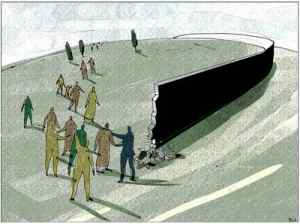What action does Paul say Christ took toward “the law of commandments expressed in ordinances” (ESV)? Why did He take this action? (See Ephesians 2:14-15.)
Paul probably alludes here to the balustrade or fence that surrounded the court of Israel in Herod’s Temple, with its death threat. Paul imagines this wall coming down and Gentiles being granted full access to worship God (Ephesians 2:18).
Any such wall, says Paul, is removed by the Cross. For there we learn that these two peoples, Jews and Gentiles, are really one.
Some believe that Ephesians 2:14-15, teaches that the Ten Commandments, inclusive of the Sabbath commandment, are “abolished” or “set aside” by the cross. However, in Ephesians, Paul demonstrates profound respect for the Ten Commandments as a resource for shaping Christian discipleship. He quotes the fifth commandment (Ephesians 6:2-3) and alludes to others (e.g., the seventh, Ephesians 5:3-14, Ephesians 5:21-33; the eighth, Ephesians 4:28; the ninth, Ephesians 4:25; the tenth, Ephesians 5:5). This aligns with Paul’s earlier assertions about the law (Romans 3:31, Romans 7:12). He addresses the misuse of the law, but he honors the law itself and assumes its continuity. Hence, to use these verses to abolish the Ten Commandments, especially in light of all the other verses in the Bible about the perpetuity of the law, is clearly a misinterpretation of Paul’s intent here.
Instead, any use of the law to drive a wedge between Jews and Gentiles and especially to exclude Gentiles from full partnership among the people of God and access to worship, would be anathema to Paul and a misuse of the divine intention for the law. The “law” in Ephesians 2:14-15, is either the ceremonial aspects of the law that divided Jew from Gentile, represented in Paul’s complex phrase, “the law of commandments expressed in ordinances” (ESV), or it is the whole Old Testament system of law as it had come to be interpreted, augmented, and misused as a wedge to distance Jews from Gentiles.
| What tensions among Seventh-day Adventists or among members of the wider Christian community need to be confronted and overcome? Why should our common love of Christ be enough to overcome these tensions? |
 (0)
(0)The post Tuesday: Breaking Down the Dividing Wall appeared first on Sabbath School Net.
Source: https://ssnet.org/blog/tuesday-breaking-down-dividing-wall/





